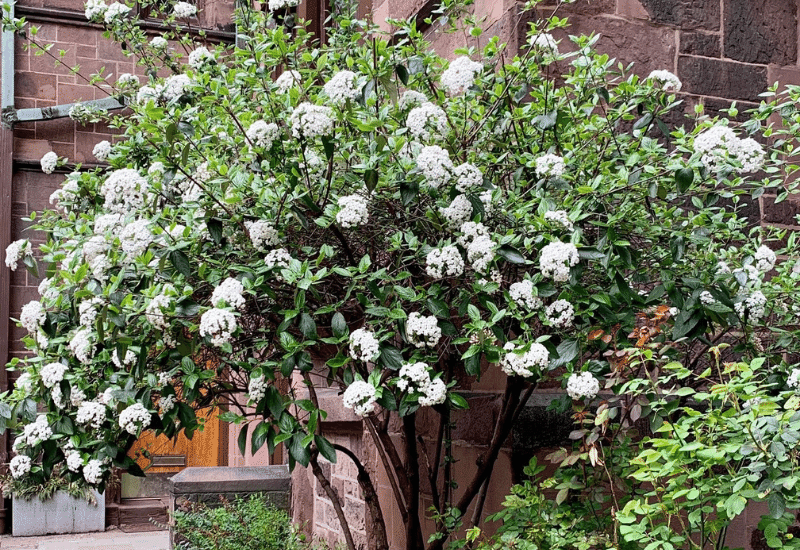
If the love affair between fragrant shrubs and gardeners goes back thousands of years, it is because they possess an almost magical power. A good garden is one that looks good, but an unforgettable one is one that smells great! And when the intoxicating fragrance comes from shrubs, it can fill large areas, whole terraces even whole parks…
For humans and for bees, birds and butterflies, the aroma of flowers and foliage is that “extra factor” that draws to plants and shrubs, and that experience we commit to long term memory.
And when we think of perfume, the first shrubs with fragrant flowers that comes to our mind is often the rose or jasmine, but it is far from having the monopoly! Indeed, there are some for all seasons and in all plant categories. Soft, sweet, musky, fruity… the palette of fragrances in the flowering bushes are just as wide as that of colors and shapes.
Plant them in your hedge, in your beds, on the terrace, near places of passage, along an alley, near the entrance to the house or under a window, these shrubs will satisfy you with their pleasantly scented blooms!
So make your garden or terrace impossible to forget, and get ready for the most fragrant article you will ever read!
We sniffed around the whole globe to find out the very best fragrant shrubs to maintain olfactory harmony in your garden all year long!
1. ‘Gertrude Jekyll’ English Rose (Rosa ‘Gertrude Jekyll‘)
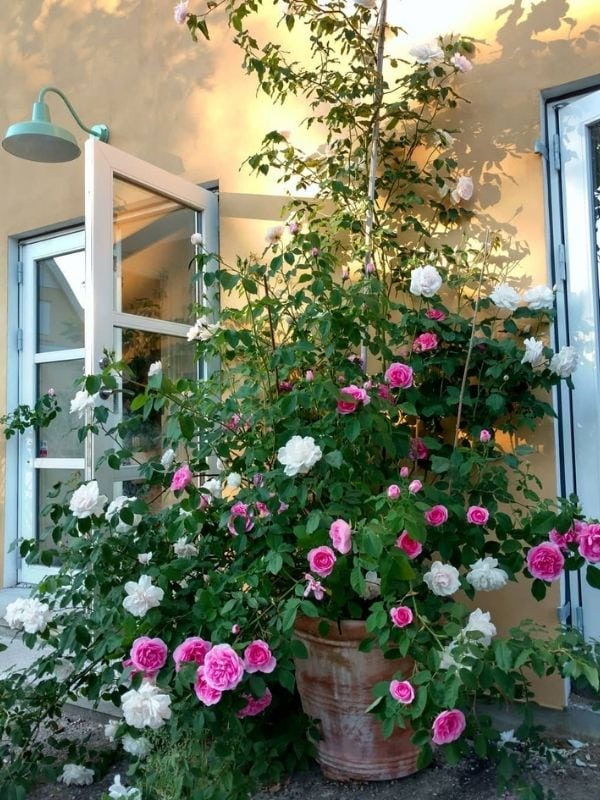
Many roses have a strong fragrance, but the English shrub variety ‘Gertrude Jekyll’ has a special and sought after one: the perfect old rose scent! This means the traditional wild rose aroma, and you can only fond it in pink and red roses. And our protagonist has large and cupped, fully double rich pink blooms that come in clusters for months!
The dark emerald green foliage makes the perfect backdrop for this profusion of color and smell.
Introduced by the now legendary breeder David Austin in 1986, it has since received the Award of Garden Merit by the Royal Horticultural Society.
The traditional and “old world” appearance of ‘Gertrude Jekyll’ makes it ideal for informal gardens, from cottage to city, in birders and beds, but also in containers on nostalgic looking terraces.
2. Cape Jasmine (Gardenia jasminoides ‘Heaven Scent’)
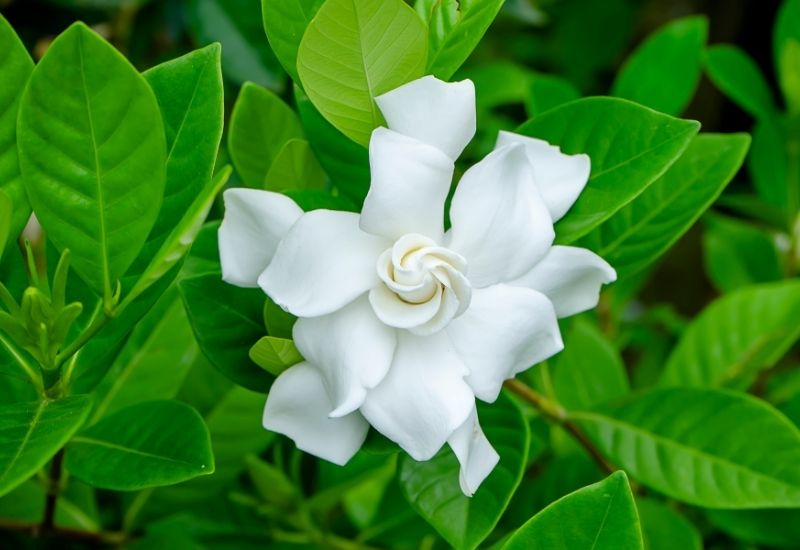
Cape jasmine is a small evergreen shrub but packed with beauty and an amazing, strong and sweet scent, typical of this plant.
The blooms are quite large, white with a yellow center and floppy petals, quite broad for this genus. They give way to bright orange pods that stay on in fall. The foliage is oval, small, glossy and dense – a lovely presence even in your winter garden.
We chose ‘Heaven Scent’ jasmine because it is small, and you can even grow it on a terrace or in a modest garden, but there are larger varieties for bigger borders, pergolas and wall sides in informal settings.
3. ‘Josee’ Reblooming Lilac (Syringa ‘Josee’)
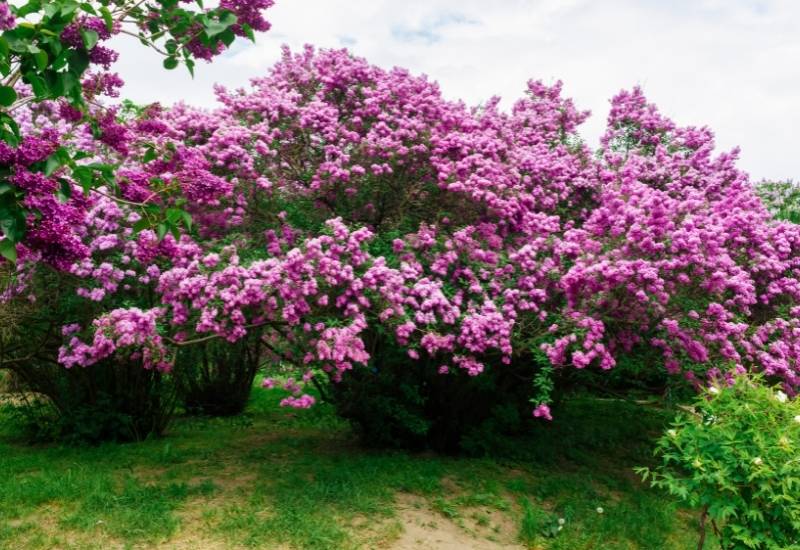
All lilac varieties are emblematic of a fragrant spring. But the bushy ‘Josee’ is also a marathon bloomer. Starting in spring and stopping with frost. So, you will have the large panicles of soft and tender fragrant pink flowers almost all year round! The first bloom will be much bigger, but still the smell will stay with you even in fall.
The lush green foliage is an extra bonus of this generous shrub, and it is a modest sized variety, so you can have it even in a small garden.
‘Josee’ reblooming lilac is perfect in a natural looking garden, in herbaceous border, hedge or windscreen, or you can use it for foundation planting and in naturalized areas. Ideal for colder regions too, including most of Canada.
4. ‘Carol Mackie’ Daphne (Daphne x burkwoodii ‘Carol Mackie’)
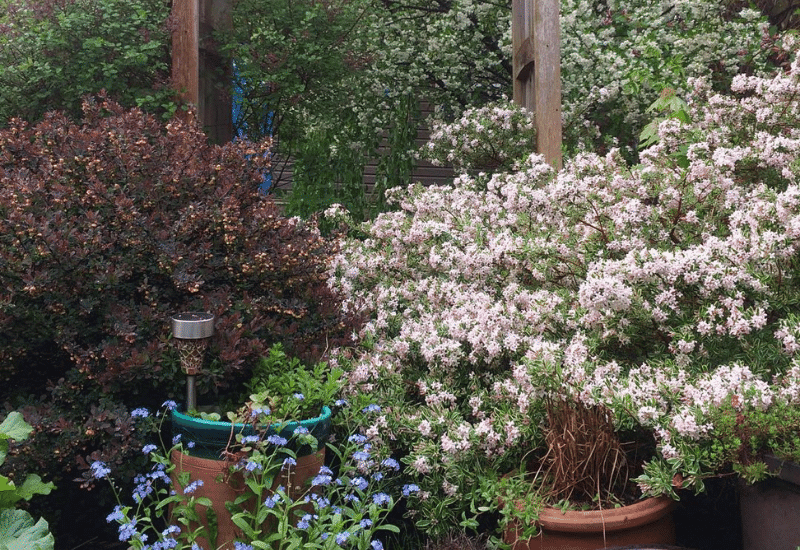
‘Carol Mackie’ has it all: a small shrub with beautiful foliage, fragrant flowers and a vibrant presence! In spring, it fills with a multitude of light pink flowers with a very sweet scent that attract lots of pollinators.
Round habit of this bush is perfect for the fine texture of the semi evergreen foliage… each leaf is oval and long, gray green with cream margins, giving you an interesting color pattern.
They are densely packed on the branches, pointing up like little fingers. I forgot… you also get red fruits to give you a final blush of color in fall!
This ever changing and fragrant shrub is high maintenance, so grow it in small gardens, like urban and suburban ones, or in “primary borders”, those near your home, which you tend more frequently, which also need to be informal. It is perfect for river banks.
5. harlequin glorybower (clerodendrum trichotomum)
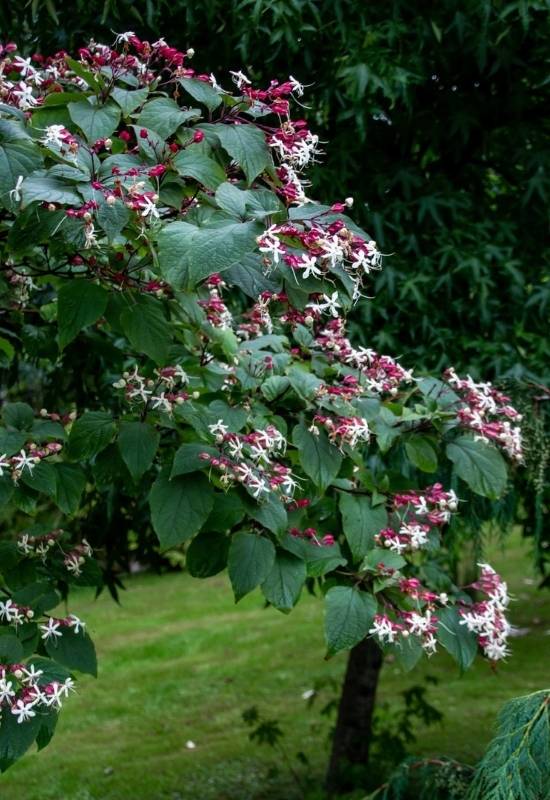
Harlequin glorybower is a large deciduous shrub or small tree with many tricks up its sleeve… The blooms are white, elegant and they come in summer in clusters with a very pleasant scent.
They then become very unusual round fruits set in the middle of a bright purple red star and they can be aquamarine or dark blue, all on the same stem! The leaves are ovate and light to dark green according to the season, soft looking and quite dense.
When in bloom it is a favorite of butterflies, bees and even hummingbirds. It’s a very intriguing and always changing plant!
Harlequin glorybower’s large size makes it suitable to big gardens in hedges, windscreens and naturalized areas in informal gardens.
6. ‘Aphrodite’ Sweetshrub (Calycanthus ‘Aphrodite’)
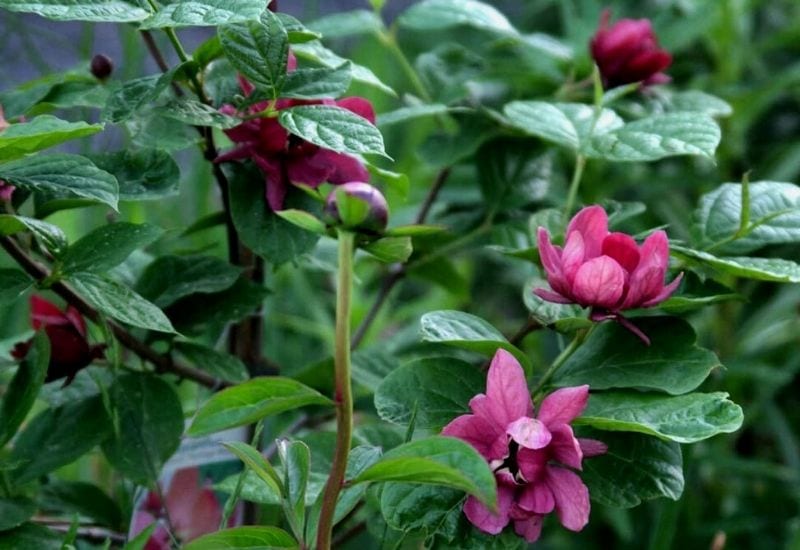
‘Aphrodite’ sweetshrub is a compact shrub with one of the most pleasant aromas of this genus: the flowers have a strong, fruity and very sweet fragrance. And they are showy too!
The blossoms are big, up to 4 inches across (10 cm) with lotus like appearance, cupped shape and fleshy dark magenta petals. They come abundantly and they look quite exotic, though it’s a cold hardy bush.
The glossy, broad and lush green foliage sets them off perfectly well and it turns gold in color once the bloom is over. The bark and the seed pod also have a nice smell if crushed, quite spicy indeed!
‘Aphrodite’ sweetshrub suits informal borders and beds in both temperate end tropical and exotic designs; the flowers are excellent as cut flowers, especially dried, as they keep their beauty for a long time.
7. Cinnamon Clethra (Clethra acuminata)
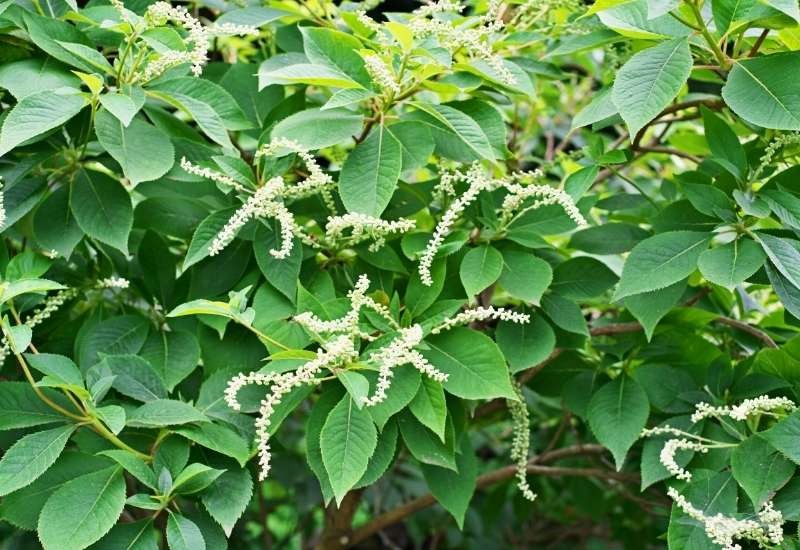
Cinnamon clethra is a medium large herbaceous shrub with purple peeling bark, hence the name. No, it does not relate to the scent, which is described as “French perfume”, and it is attractive to pollinators.
This summer flowering shrub comes with the white white bell shaped blooms that open on in racemes at the end of the very regular, layered branches.
They are followed by round capsules that stay on in winter, where the plant still looks interesting, thanks to the elegance of the branches. The leaves are broad, they start off green in spring and they turn golden yellow in fall.
Cinnamon clethra has a wild look, so it is only suitable for large hedges, windscreens and borders in traditional, informal gardens or naturalized areas. It is ideal under trees and in dark places.
8. ‘Silver Poise’ Thyme (Thymus ‘Silver Poise’)
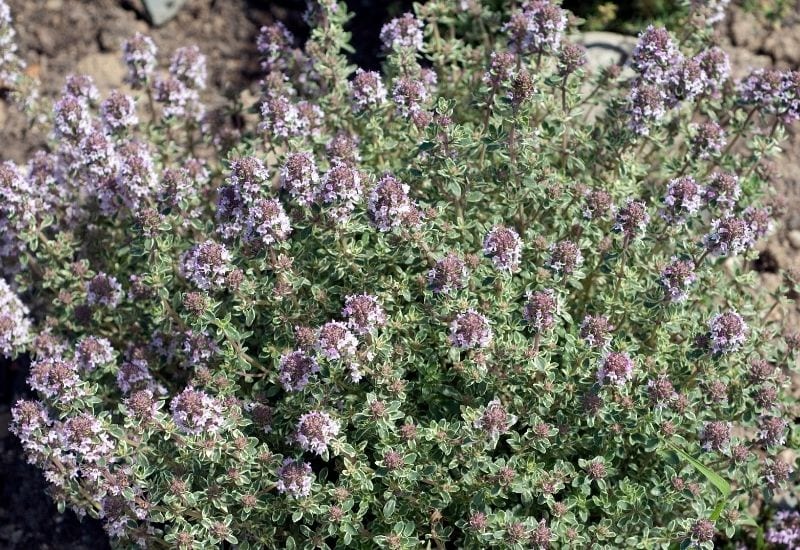
All thyme varieties have a distinctive and iconic fragrance, but we picked one, ‘Silver Poise’ for you. The whole of this small shrub is highly aromatic, leaves and branches included. You will love it for its thick and decorative foliage on the upward purple branches because…
The fine texture is one thing, and each tiny ovate leaf is gray green in the middle, white at the margin and it has a dash of pink at the tip! What an explosion of color! In late spring, it will also fill with tubular white to bright purple flowers too!
This small variety of thyme is ideal for rock gardens, flower beds, containers and its ideal setting is a Mediterranean garden; but don’t worry if you don’t have one, it adapts to most themes.
9. ‘Halliana’ Japanese Honeysuckle (Lonicera japonica ‘Halliana’)
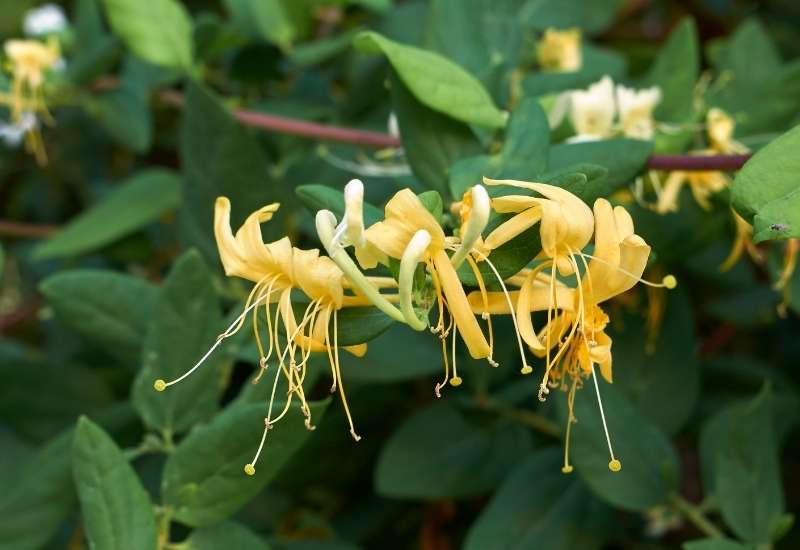
Japanese honeysuckle is a much more fragrant shrub than common honeysuckle, and ‘Halliana’ is a vigorous vining cultivar with white tubular flowers that fill with pollinators and hummingbirds attracted by its sweet scent.
They will turn into cream yellow as they mature, giving you an interesting twist. The foliage is lush and mid green, elliptical and evergreen in warm countries, while it will shed in colder climates. It has a rambling habit and it may even become invasive in natural areas.
‘Halliana’ Japanese honeysuckle is ideal to cover walls and fences allowing it to climb over them and then drape them, or for harbors, pergolas and gazebos. You could also let it sprawl over a slope as ground cover. Despite its origin, it is fairly cold hardy.
10: Bodnant Viburnum (Viburnum bodnantense)
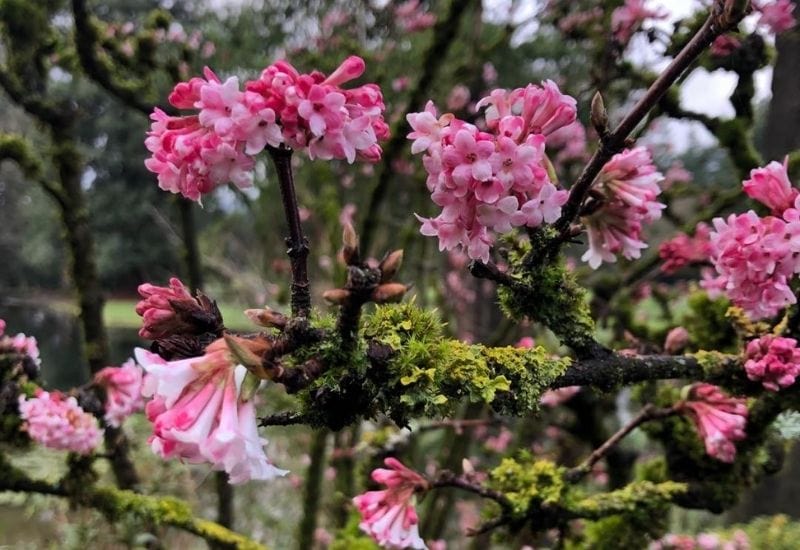
When it flowers on its bare stems, between November and February, the Viburnum of Bodnante brings a touch of gaiety to the greyness.
Its bright pink buds bloom into many bouquets of pale pink flowers with a sweet scent, surprising in the heart of winter.
Its vanilla notes, mixing heliotrope and carnation, are particularly noticeable when the weather warms up a bit.
Its foliage, deciduous and strongly ribbed, takes over in spring, in bronze tones, before turning green in season, then turning purple-red in autumn.
Bodante’s Viburnum varieties, ‘Dawn’ and ‘Charles Lamont’, are quite similar.
In the front garden or near an entrance or walk, in an isolated subject or even in informal hedges, it will require almost no maintenance to bloom abundantly throughout the winter.
11. ‘Black Lace’ Elderberry (Sambucus nigra ‘Black Lace’)
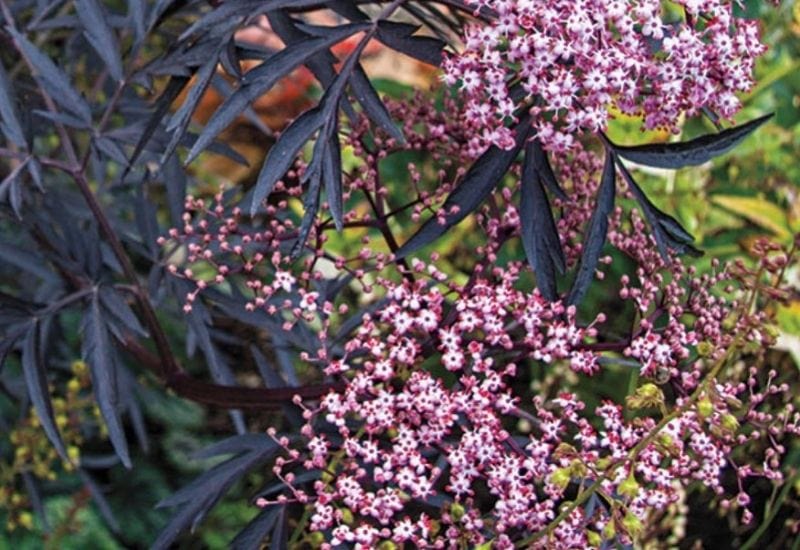
‘Black Lace’ is an upright shrub with impressive foliage and aromatic blooms. The leaves are pinnate and almost black (dark purple), with a very fine and decorative texture. The white and light pink blooms are made up of many tiny flowers in large umbels, and they have a distinctive lemon fragrance!
They give way to clusters of black berries that grave your garden in the later months of the year. It is a “dark winner” of the Award of Garden Merit by the Royal Horticultural Society.
‘Black Lace’ elderberry is a very striking plant and a bold statement; it can add drama to any informal garden in borders and hedges, and you may even grow it as a specimen plant for its unusual and gothic look.
12. Florida Anise (Illicium floridanum)
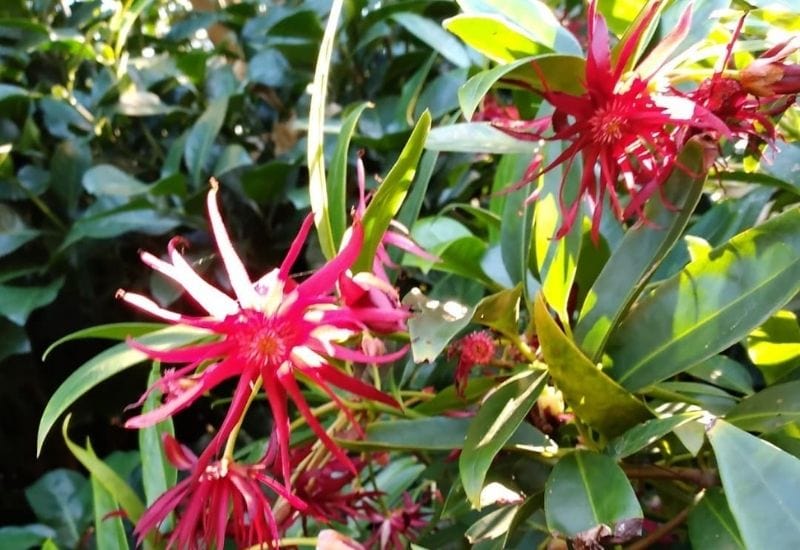
Florida anise is a rare beauty with a nice smell! This medium sized exotic shrub has dark red to maroon flowers with unpleasant smell, yes, unpleasant, and they look like starfish! They are about 2 inches across (5.0 cm), but they stay in for 6 weeks maximum.
On the other hand, the leathery, glossy lime to olive green foliage has an intoxicating pleasant fragrance of “gin and tonic”! It is a protected species, so if you grow it you get an unusual plant with contrasting smells but you also help its survival…
Florida anise is low maintenance and easy to grow, ideal for informal gardens with an exotic look, including Mediterranean and urban gardens. It is also ideal for wet areas.
13. Creeping Rosemary (Rosmarinus officinalis prostratus)
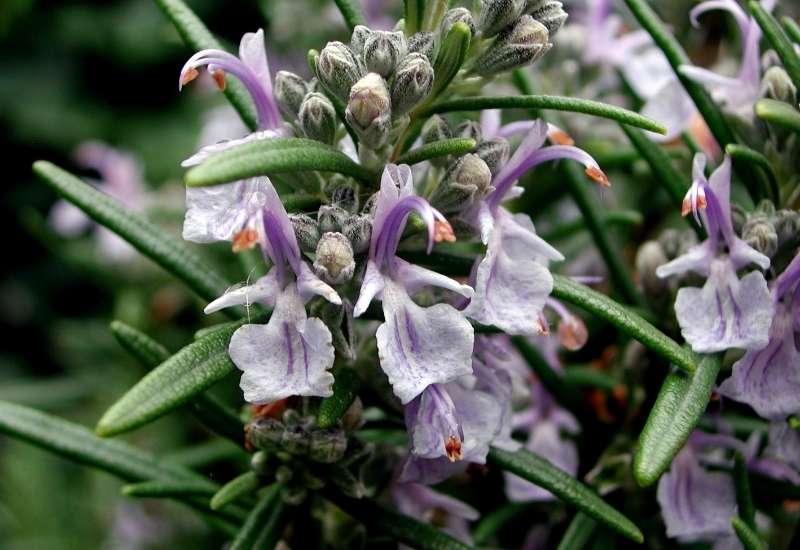
All rosemary shrubs have aromatic foliage, and creeping rosemary also has draping, trailing branches and a spreading habit. By the way, there are varieties with a different fragrance from the rosemary we use in the kitchen, more soapy…
The evergreen needle shaped foliage will bring a strong smell all year round, while from mid spring to the end of summer you will also have lots of bees, butterflies and pollinators visiting the myriad little lavender blue flowers that crowd the branches. Of course, you can use it to cook as well!
Creeping rosemary is perfect in rock gardens and low flower beds, but also in containers, even hanging baskets. It will grow well in coastal areas as well, as it is salt tolerant. Alternatively, use it as ground cover, even in dry places. PS: do not harvest it when it’s in bloom.
14. ‘Mohawk’ Burkwood Viburnum (Viburnum burkwoodii ‘Mohawk’)
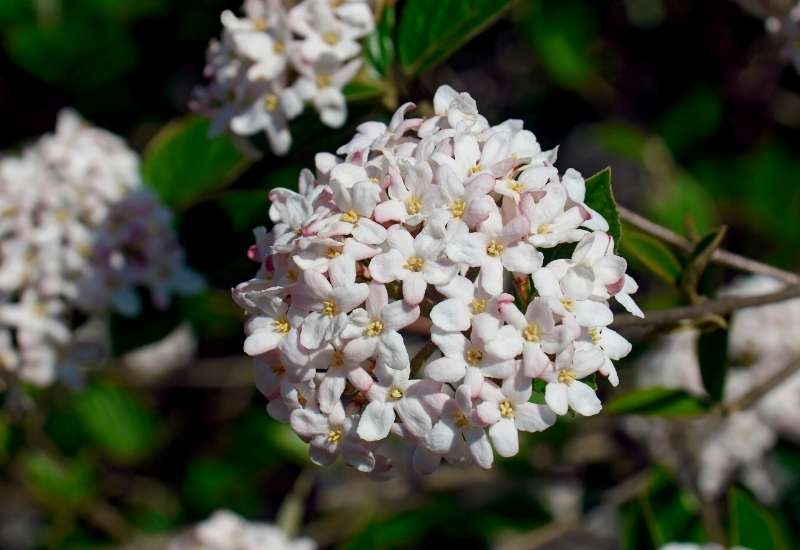
‘Mohawk’ is one of the most fragrant varieties of viburnum, a medium evergreen shrub with lots to offer. The round umbels of bright white flowers with a yellow dot in the middle and pink bushes on the tips are highly sweet smelling and pretty at the same time.
Red berries follow them, and they ripen to black in late summer. The foliage is semi evergreen, ovate, glossy and dark green, but it takes on touches of orange in fall if you live in USDA zones 4 to 6. It has received the famous Award of Garden Merit by the Royal Horticultural Society.
Grow ‘Mohawk’ burkwood vibernum as foundation planting, specimen plant or in hedges and borders in natural looking gardens, even coastal gardens. It also makes a good wall side shrub, and it can bring lush foliage to dry gardens.
15. ‘Royal Purple’ English Lavender (Lavandula angustifolia ‘Royal Purple’)
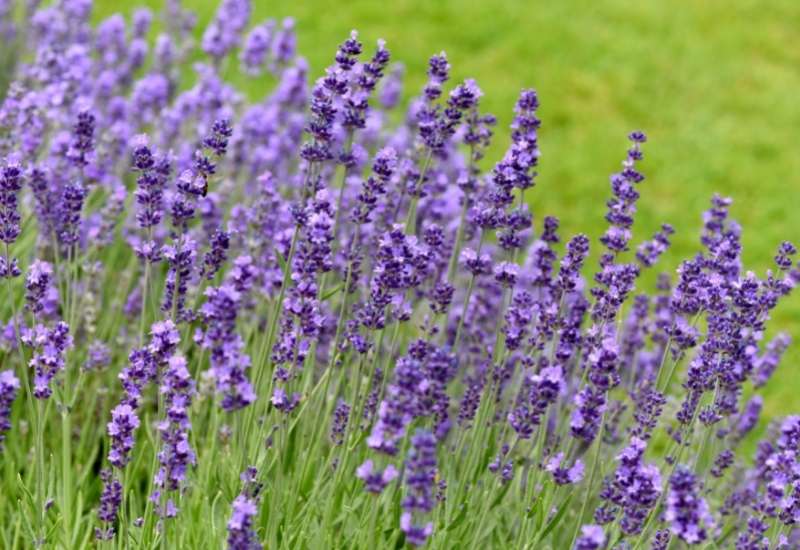
Which better plant to close the list of fragrant shrubs than lavender? And English lavender is both the best smelling and hardiest of all. And we chose utter royalty: ‘Royal Purple’!
Introduced in the 1940s, this variety has the classically strong perfume scent of Lavandula angustifolia, and it couples it with deep violet purple blooms that brighten up your summer days on long, upright stems.
The foliage is on the green side and very aromatic too, just stroke it with your hand and have a sniff of peaceful heaven. On top of this, it is a magnet for bees, butterflies and pollinators like no other plant you can grow in your garden!
‘Royal Blue’ is a low maintenance, sturdy shrub for low hedges or birders and beds, really adaptable to any design, and the generosity of this plant is a real asset: you really get lots for so very little work!
16: Burkwood Viburnum (Viburnum burkwoodii)
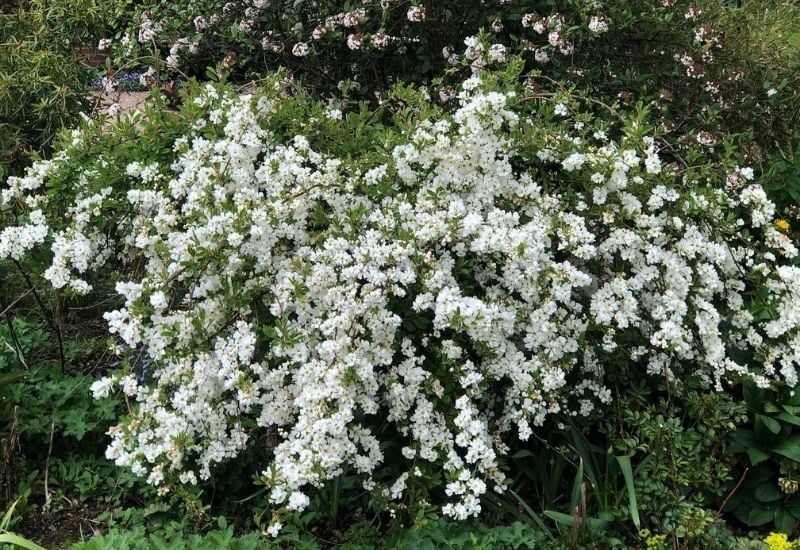
Essential in a fragrant garden, the Burkwood Viburnum illuminates the spring with its small white flowers tinged with pale pink gathered in numerous balls of about ten centimeters.
Its perfume is then a pure marvel! Close to that of the lily, it also exudes notes of jasmine and tuberose. Very powerful, it is really noticeable for several meters around! The foliage, deciduous to semi-evergreen is carried by a shrub of about 2.50 m, with a sometimes a little disordered habit.
Green in season, the leaves make this superb shrub stand out again in autumn, when they take on particularly warm colors.
Hardy down to -20°C, this specie of Viburnum is easy to live with and plays the star of the garden several times a year. The variety ‘Ann Russell’ differs from the type by a smaller development and a more compact habit.
Smells, Colors and More with Fragrant Shrubs in Your Garden!
I told you that this would be the most fragrant article ever…
You can literally crate a “smellscape” in your garden and even on your terrace using these aromatic shrubs! You can couple them with other sweet smelling plants, like phlox, daffodils and carnations, to have a fully intoxicating green haven.
This way, wherever you walk among your plants, you will be enveloped by sweet, pungent, aromatic, fruity pleasures – not just for your eyes though… for your nose too!

Written By
Adriano Bulla
After many years as an academic in London, Adriano Bulla became a writer, publishing books like A History of Gardening, Organic Gardening and Elements of Garden Design; he then decided to become a gardener, following his childhood dream, and has been following his dream writing and gardening professionally in Southern Europe, where he has specialized in new and innovative organic gardening fields and techniques, like permaculture, regenerative agriculture, food forests and hydroponics.
